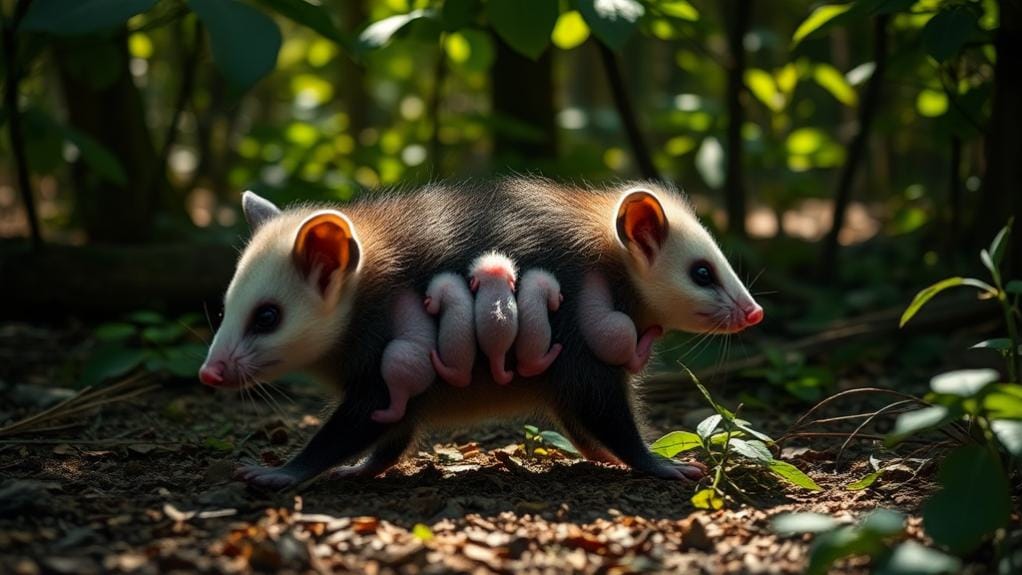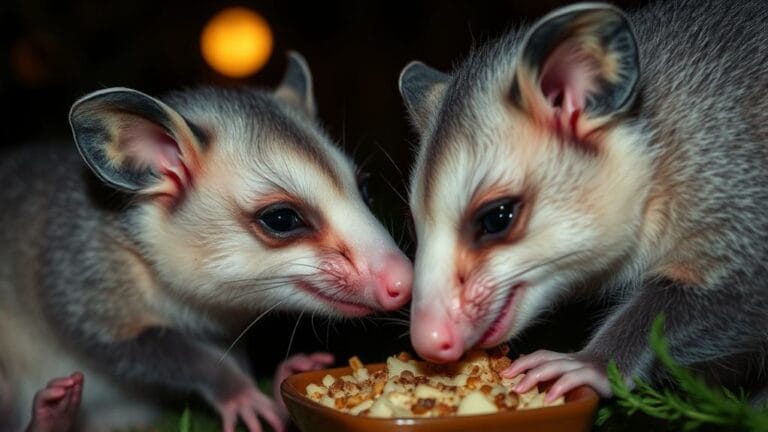Let me tell you how baby possums ride on their mom – it's quite the journey! These tiny creatures start life in mom's cozy pouch for 6-7 weeks, latching onto one of her 13 nipples. Once they're ready (around rat-size), they graduate to piggyback rides by gripping her fur with their strong feet and prehensile tails – nature's perfect seatbelt! They'll stay on mom's back until about 12 weeks old, learning essential survival skills while she acts as their personal jungle gym. It's not just a free ride – it's survival school in action. Stick around to discover what these little acrobats do next.
Early Life in the Pouch
Table of Contents
The first weeks of a baby opossum's life revolve entirely around its mother's protective pouch. I'm talking about seriously underdeveloped babies here – they're basically embryos that need to finish growing after birth. Talk about being born early to the party!
While disease concerns exist with adult opossums, newborns in the pouch are protected from environmental threats.
Let me tell you how this works. These tiny baby opossums make an incredible journey to their mom's pouch, where they'll each latch onto one of her 13 nipples. Yes, you read that right – 13 nipples! Nature's got some interesting math going on there.
Pro tip: If you're wondering why they need that pouch time, it's because they'll spend 6-7 weeks fundamentally "cooking" in there until they're developed enough to face the world.
They're completely dependent on mom during this time – no Instagram-worthy adventures just yet!
Preparing for Back Rides
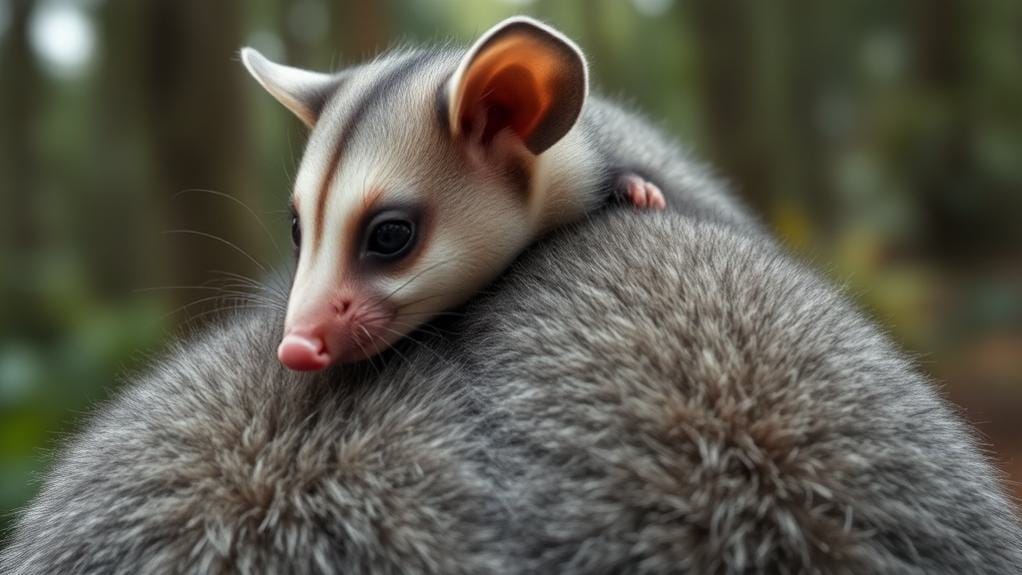
After those cozy weeks in the pouch, baby opossums start gearing up for their next big adventure – riding on mom's back. At about 6-7 weeks old, these little hitchhikers are finally ready to see the world from a whole new perspective.
As natural pest controllers, these babies will soon learn essential hunting and foraging skills from their mother. And trust me, it's quite the upgrade from pouch life!
Think of it as nature's piggyback ride. The young are born with everything they need to become expert back-riders. Their feet and tails? They're basically built-in safety harnesses!
While mom's out there doing her thing (you know, surviving and all), these tiny passengers are getting a firsthand lesson in Opossum Life 101.
*Pro Tip: This isn't just a fun ride – it's survival training! Those elevated views help babies develop vital climbing skills while mom handles the heavy lifting.*
Climbing Techniques and Balance
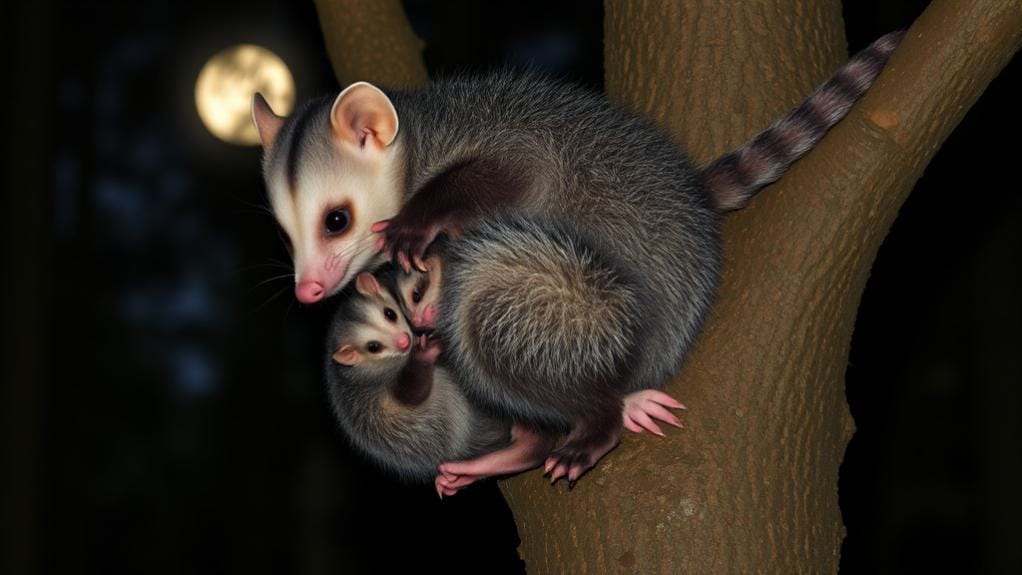
Clinging tightly to their mother's fur, baby opossums showcase remarkable climbing abilities from their earliest back-riding adventures. Their strong feet and prehensile tails are like built-in safety harnesses – and trust me, they know how to use them.
Even typically aggressive possums display gentle, peaceful behavior when carrying their young.
You'll see young opossums constantly shifting positions on mom's back. It's not because they're restless (okay, maybe a little). They're actually perfecting their balance and coordination. Pretty smart, right?
Here's what makes these little acrobats so impressive:
- They maintain grip even when mom's racing through rough terrain
- Their tail acts like a fifth limb for extra stability
- They conserve energy while still learning survival skills
*Pro Tip: Watch how they adjust their position depending on mom's movements. It's like a miniature gymnastics routine – except falling isn't an option.*
Mother's Role During Transport
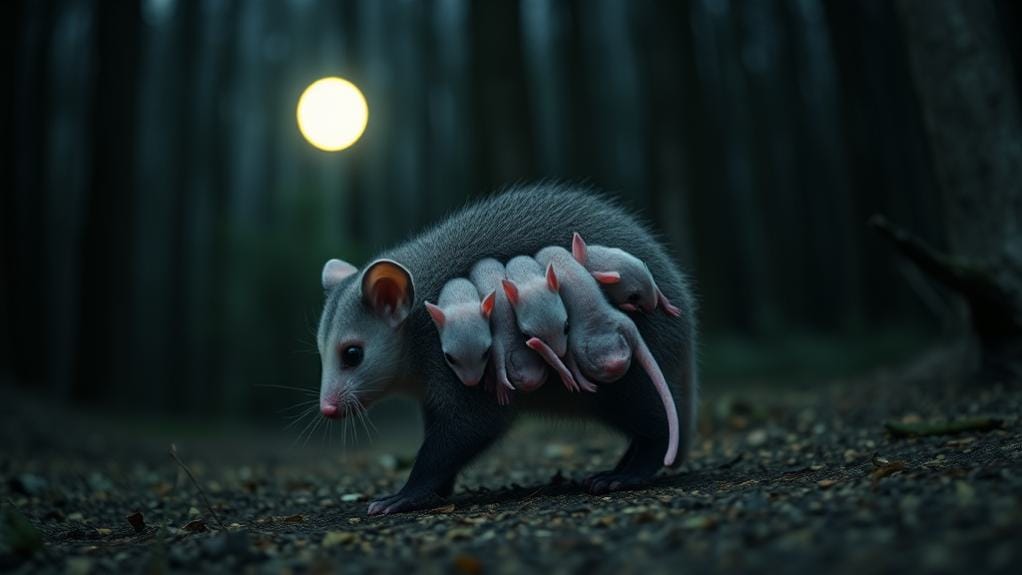
While effortlessly balancing her precious cargo, a mother opossum transforms into a living playground as her babies explore the world from the safety of her back. You'd think carrying multiple clingy babies would slow her down, but mom's got skills!
| Mom's Role | Baby's Response |
|---|---|
| Provides transport | Clings with feet & tail |
| Guarantees safety | Makes anxious sounds if separated |
| Offers comfort | Stays close for security |
| Enables exploration | Learns surroundings |
| Supports independence | Gradually ventures out |
Let me tell you – it's not easy being a mobile jungle gym! The mom's back becomes home base while these little adventurers figure out their world. When babies vocalize their anxiety (yeah, they're total momma's boys), she's right there keeping them secure. *Pro tip: If you spot a possum mom with babies, just let her do her thing – she's got this parenting gig down pat.*
Safety Through Movement
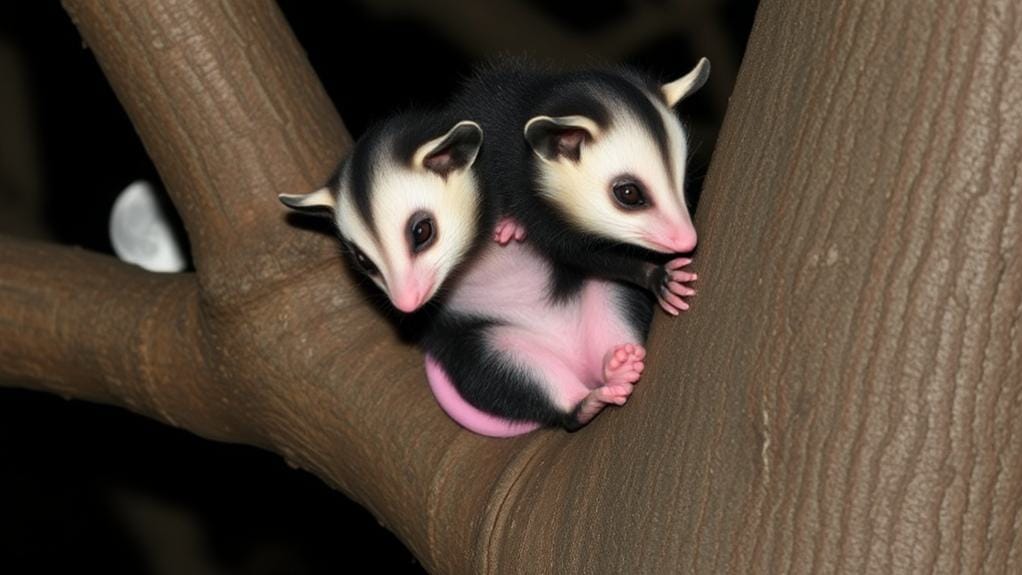
The mother opossum's mobile babysitting service isn't just about transportation – it's a brilliant survival strategy. When you think about it, it's like nature's version of a fortress on the move.
These solitary and nocturnal marsupials rely heavily on this carrying technique as they forage through various habitats.
You'll spot opossums often carrying their babies this way, and there's a good reason. While mom navigates branches and forages for food, those little ones get a free ride away from ground predators. Pretty smart, right?
Here's what makes this survival tactic work:
- Babies grip with both feet and tails (no seatbelts needed!)
- They're positioned for a quick escape if needed
- The elevated position gives them a safer view of their world
*Pro Tip: If you ever see a mother opossum with babies on her back, keep your distance. She's not running a petting zoo – she's teaching survival skills 101.*
Learning Through Observation
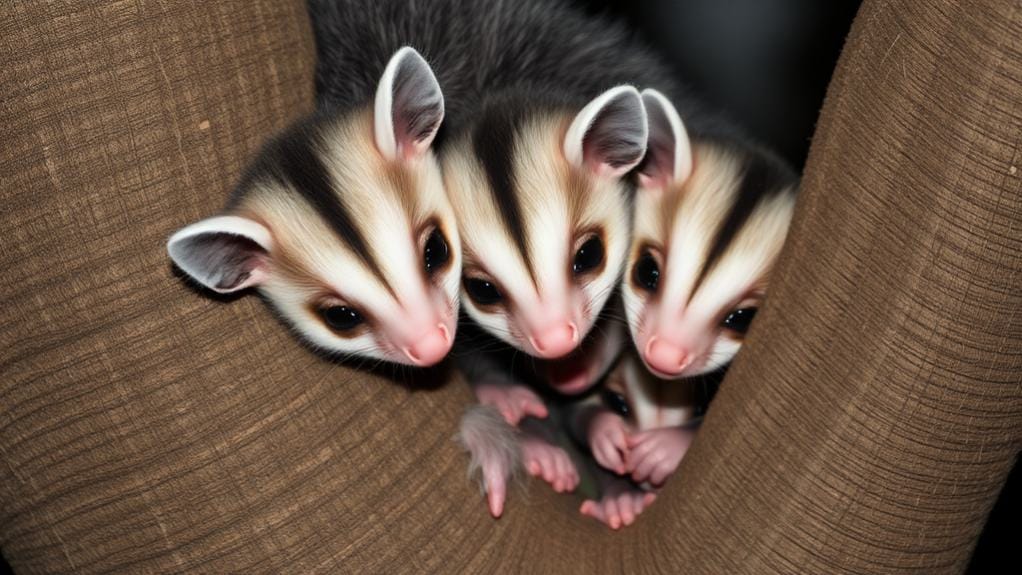
Every ride on mom's back serves as a live-action survival tutorial for baby opossums. Think of it as nature's version of a field trip – except you're clinging to fur instead of holding a permission slip.
Since opossums are primarily nocturnal creatures, these nighttime journeys help babies learn when it's safest to venture out.
Let me tell you why this piggyback arrangement is genius. These baby opossums aren't just getting a free ride – they're getting front-row seats to their future survival. From their high perch, they watch mom's every move: how she finds food, where she takes shelter, and which areas she avoids.
Pro tip: You'll notice these babies making worried little sounds if they get separated. That's not just drama – it's their built-in GPS calling them back to their mobile classroom.
The more they observe from mom's back, the better prepared they'll be for solo adventures later.
Duration of Back-Riding Period
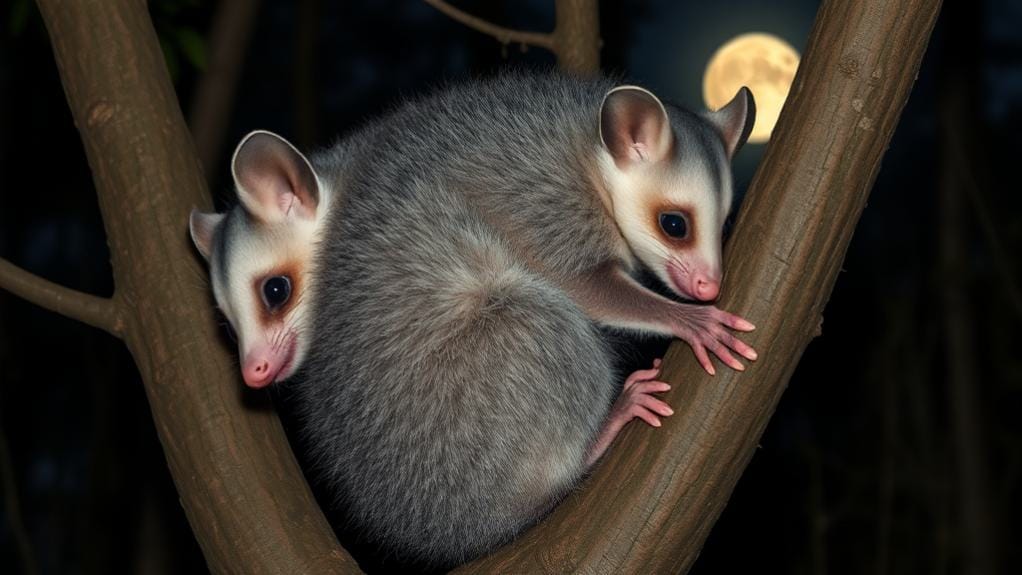
After mastering their observation skills, baby opossums need time to perfect their back-riding technique. These fascinating North American marsupials spend about six weeks hitching rides on mom's back. And trust me – it's quite the sight to behold!
Let me break down this peculiar piggyback period for you:
- Baby opossums start their back-riding adventures at 6-7 weeks old (right after they leave the pouch)
- They'll keep riding until they're roughly rat-sized – that's around 12 weeks
- By 14 weeks, these little acrobats are ready to venture out on their own
During this time, you'd swear mom's turned into a moving jungle gym! She'll cart these clingy kiddos around while they learn the ropes of opossum life.
*Pro tip: If you spot a mama opossum with babies on board, give her plenty of space to do her thing.*
Physical Development While Riding
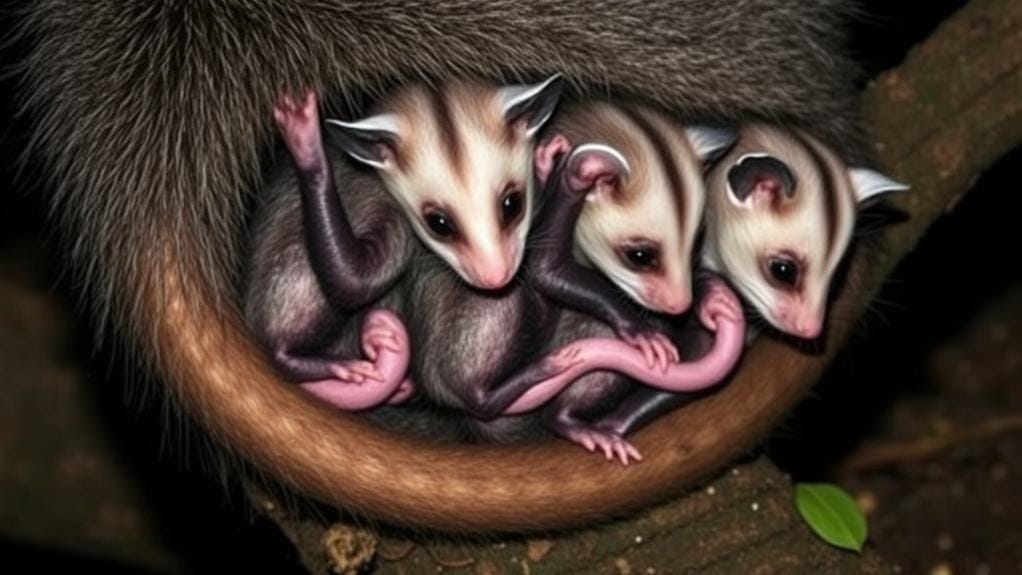
Nature's gymnasts, baby opossums undergo remarkable physical changes during their back-riding phase. I'm telling you, these little acrobats don't waste any time once they've arrived on mom's back at 6-7 weeks old.
You'll see them transform from tiny hitchhikers to rat-sized adventurers before you know it.
Let me break down what happens while they're up there:
- Their feet and tails get stronger daily (yep, those tails are basically fifth limbs)
- They're literally learning the ropes of climbing while mom does the heavy lifting
- Multiple siblings can pile on mom's back – it's like a furry bus service!
*Pro tip: Don't mistake this for lazy parenting. Mom's giving them the ultimate survival training while keeping them warm and well-fed. Pretty clever, right?*
Sibling Dynamics During Travel
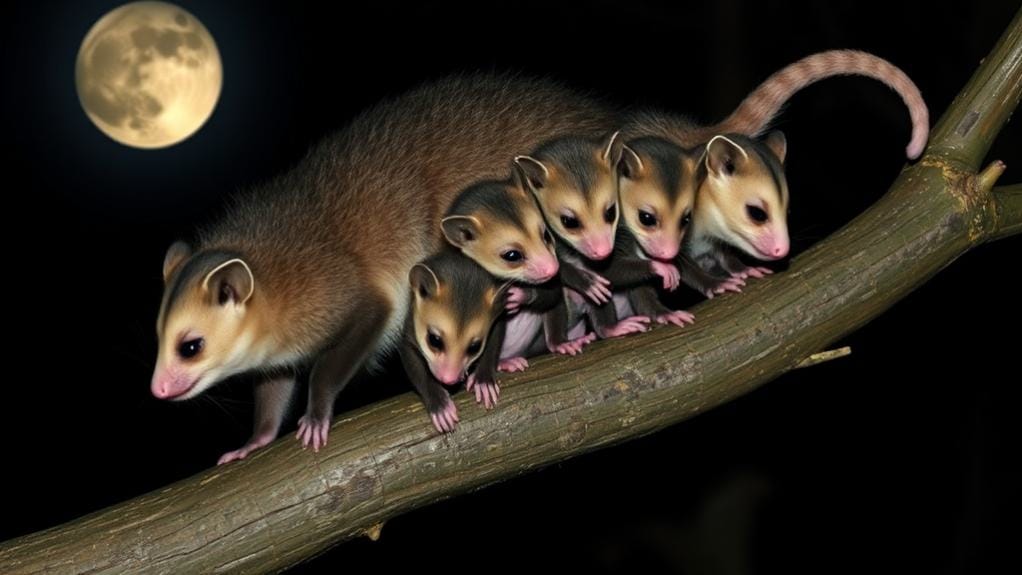
Like a furry carpool, opossum siblings create quite the spectacle when hitching a ride on mom's back. You'll see them clumped together, hanging on for dear life while mom's out searching for food. It's actually pretty genius – these little hitchhikers have figured out the buddy system.
- They bunch up in a warm, wiggly pile that keeps everyone cozy
- Each baby learns to adjust their position as siblings shift around
- Playful competition helps them develop better climbing skills
While you might think it's chaos up there, these siblings are actually mastering some serious survival skills. They're learning balance, coordination, and how to deal with that one annoying brother who always wants the best spot.
*Pro tip: Watch how they use their tails like tiny seat belts – nature's way of keeping everyone safely onboard.*
Transitioning to Independence
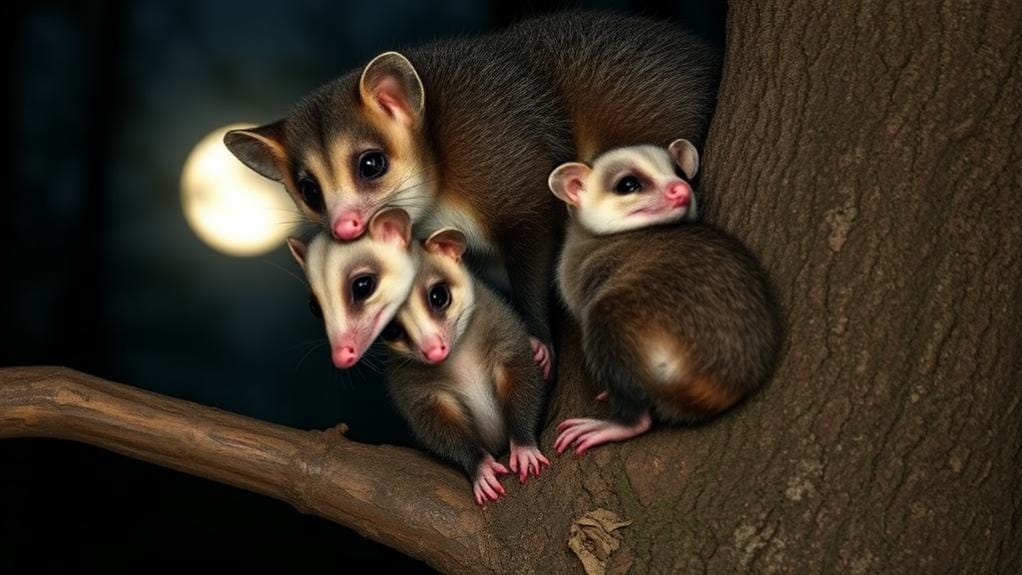
The journey to independence begins when baby opossums reach about 6 weeks old, trading their cozy pouch life for adventurous piggyback rides. You'll watch these tiny acrobats cling to mom's back while she helps us understand nature's perfect design for survival.
| Stage | Age | Activity |
|---|---|---|
| Early Rider | 6-7 weeks | First backrides |
| Pro Explorer | 10-12 weeks | Climbing practice |
| Solo Artist | 14+ weeks | Independent foraging |
Let's be real – these little guys don't just wake up one day and say "See ya, Mom!" It's a process. They're practicing their climbing skills, switching from milk to solid food, and getting braver by the day. *Pro tip: If you spot a young opossum alone, don't assume it's lost – it might just be embracing its newfound independence!*
Frequently Asked Questions
How Do Baby Possums Hold on to Mom?
I'll tell you how baby possums stay secure – they use their strong feet and prehensile tails to grip tightly onto mom's back. They'll start doing this around 6-7 weeks old while learning to explore.
Why Do Possums Ride Their Mom?
I'll tell you why these clever babies ride mom: it's their ticket to survival! They're staying close for protection, learning essential skills, and conserving energy while they grow stronger and more independent each day.
What Happens if a Baby Opossum Falls off of Mom?
I'll tell you what happens: if a baby opossum falls off mom, it'll cry out for help. Without quick rescue, it risks death from exposure or predators, and might lose its nursing spot permanently.
Do Possums Carry Their Babies on Their Backs?
You'd think possums are lazy parents, but I'm here to tell you they're amazing moms! They absolutely carry their babies on their backs once the little ones outgrow the pouch around 8 weeks old.
Last Word
Let me tell you – watching possum babies ride on their mom's back is like seeing tiny acrobats in a furry circus. They'll start in the pouch, graduate to piggyback rides, and eventually venture out on their own. If you're lucky enough to spot this natural spectacle, keep your distance. These little hitchhikers are mastering vital survival skills, and mom's got enough on her plate without dealing with nosy humans. Trust me – they've got this routine down pat.

